


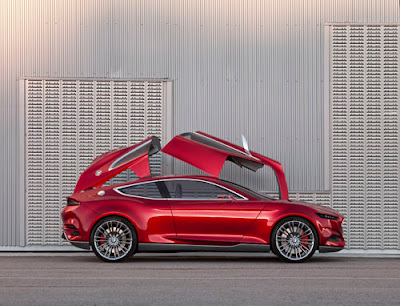
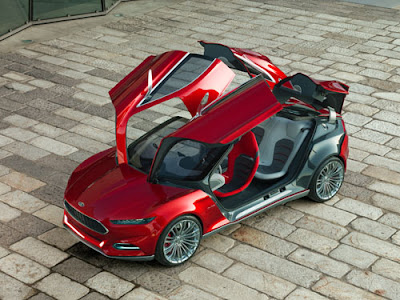
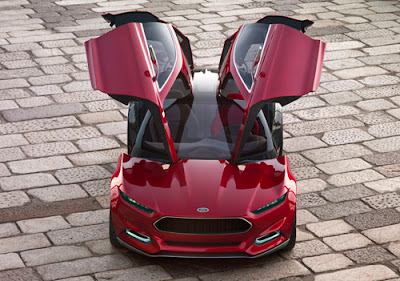

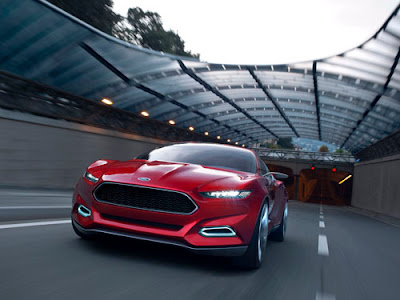

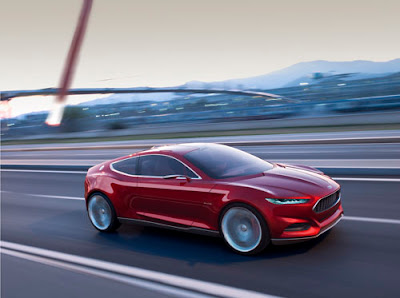 2012 Ford Evos
2012 Ford Evos
On the 2005 Frankfurt auto show, Ford’s beautiful Iosis idea automotive debuted the company’s “Kinetic” design language, which shortly thereafter debuted on non-U.S. fashions like the Mondeo, European Focus, C-Max, and Kuga. Our first style of Kinetic design got here more lately with the 2011 Fiesta and 2012 Focus models. But now Ford’s look is evolving, with another Frankfurt idea-the 2011 present’s gorgeous and aptly named Evos-previewing the subsequent evolution (get it?) of Blue Oval design.
Sadly, the company received’t go as far as to adapt the Evos’s quad butterfly doors for production. However this fastback four-seater, which is shorter than a Focus sedan however wider than a Porsche Panamera, does embody a half dozen newly defined pillars of Ford global design-which is able to drop the Kinetic moniker. The Evos will provide the template for future Fords, and so we took a digital tour of the automobile with Ford design chief J Mays, who defined those design pillars.
Ford’s New International Design Language, Explained
The first two pillars of Ford’s new design language are “silhouette innovation” and “perceived efficiency.” The previous, in response to Mays, represents a profile “that defines your automobile and looks totally different than a lot of the different cars in a specific class on the highway,” whereas the latter equates to visible lightness and sleekness. “We’d prefer to have light-weight pillars [and] a teardrop cabin [where] the strains on the side disappear at a vanishing level someplace around one hundred yards behind the car.” The gist? Think less ‘traditional three-field sedan’ and extra ‘4-door coupe.’
“Refined surface language” refers to a smoothing out of Kinetically sculpted body surfaces, among them the architectural fenders, creased door skins, and sculpted hoods. This directive also seems to be a reaction to different producers that Mays claims have “annexed” and subsequently exaggerated Ford’s Kinetic motifs. Ford goes in “precisely the opposite direction” now, he stated, keeping what he known as the “pleasure” of Kinetic design but rendered in “beautiful shapes you’d love to run your palms over.”
An emphasis on the fourth pillar, “technical graphics,” mainly refers back to the lamps and decrease body addenda. “Headlamps appear to be growing to absurd proportions,” said Mays. “They’ve change into much less about know-how and more about design flourish and style. And we expect that’s reached its complete evolution. So we’re going to the minimal peak for the headlamps and the taillamps and we’re going to let the expertise speak for the graphics reasonably than overt style.” The headlamps on the Evos are rendered in LEDs “designed in such a approach that you probably haven’t seen before.” Will each future Ford model get “razor-lower” headlamps corresponding to these? Yes, and Mays told us that he is dedicated to LED headlamps on every new Ford, though we’ll have to see if these make it previous the accountants.
The ultimate two newly defined design-isms are the “new face of Ford,” which includes pulling the trapezoid grille approach as much as the forefront of the hood (it provides the Evos a sort of Mustang-esque shark nostril), and a “visual sense of premium quality,” which-apart from being much less catchy than the others-basically means creating the sort of designs folks affiliate with greater-end cars. “We’ve tried to get rid of one of many grilles on the automobile, and deal with the other. And what that does is permit us to have a smaller inlet, offers us better aerodynamics, and also, I feel, seems to be much more premium.”
If roadgoing Fords end up wanting just like the Evos, we are saying “mission completed” to the premium bit. Certainly, various of us think that the “new face of Ford” appears to be like a lot like the current face of Aston Martin, notably, the slim, six-sided grille and Rapide-esque roofline. Might Ford be suffering from a case of “seller’s remorse” after getting rid of Aston Martin during the great hearth sale of 2008? Mays didn’t admit any such-to borrow his personal time period-annexation of Aston’s designs, however when asked in regards to the similarities, he seemed slightly comfortable with the comparison.
Head within the “Cloud”
Nevertheless Aston-y the Evos seems to be, it wouldn’t be a show automotive if it didn’t include a boatload of future tech. Cloud-primarily based connectivity supposedly helps the Evos establish and pre-prepare its various methods to match the preferences of the upcoming drive, thus promising “seamless connectivity” from residence to car to workplace, which may or may not be a very good thing. It also gauges the skills of the driver and, reconciling them with weather and highway conditions, adjusts the powertrain and chassis to maintain “optimum security”-which sounds a bit Hal 9000 to us. Then there are the “driver wellness” features, too, which include a coronary heart-charge monitor; the car is ready to use current and previous data by way of the cloud to watch “the physical state and workload of the driver and adjusts the driving expertise accordingly.” To the good, in case you start driving aggressively, the Evos may also simplify the gauge cluster to provide solely mandatory information and switch the driving force’s telephone to “don't disturb mode.”
The Evos is powered by-what else?-the cloud. Simply kidding. It features a lithium-ion-based, plug-in gasoline/electrical powertrain that’s said to have the ability to deliver extended-range or parallel-hybrid propulsion, ultimately delivering the identical type of fuel economy as the Ford C-Max Energi that’s scheduled to reach stateside next year. Ford gave no extra particulars on the powertrain past this: The cloud would theoretically be heavily concerned, directing the automobile when to make various on-the-fly powertrain changes, resembling switching to electric mode when driving into a metropolis center that may have emissions restrictions.
We won’t have to attend long to see the look previewed here on a saleable Ford product. The 2013 Fusion will be the first Ford to wear the brand new design language; we expect to see that automobile subsequent January at the Detroit show. In the meantime, if you can also make it to Frankfurt, take a look at the Evos-it’s a stunner.
Sadly, the company received’t go as far as to adapt the Evos’s quad butterfly doors for production. However this fastback four-seater, which is shorter than a Focus sedan however wider than a Porsche Panamera, does embody a half dozen newly defined pillars of Ford global design-which is able to drop the Kinetic moniker. The Evos will provide the template for future Fords, and so we took a digital tour of the automobile with Ford design chief J Mays, who defined those design pillars.
Ford’s New International Design Language, Explained
The first two pillars of Ford’s new design language are “silhouette innovation” and “perceived efficiency.” The previous, in response to Mays, represents a profile “that defines your automobile and looks totally different than a lot of the different cars in a specific class on the highway,” whereas the latter equates to visible lightness and sleekness. “We’d prefer to have light-weight pillars [and] a teardrop cabin [where] the strains on the side disappear at a vanishing level someplace around one hundred yards behind the car.” The gist? Think less ‘traditional three-field sedan’ and extra ‘4-door coupe.’
“Refined surface language” refers to a smoothing out of Kinetically sculpted body surfaces, among them the architectural fenders, creased door skins, and sculpted hoods. This directive also seems to be a reaction to different producers that Mays claims have “annexed” and subsequently exaggerated Ford’s Kinetic motifs. Ford goes in “precisely the opposite direction” now, he stated, keeping what he known as the “pleasure” of Kinetic design but rendered in “beautiful shapes you’d love to run your palms over.”
An emphasis on the fourth pillar, “technical graphics,” mainly refers back to the lamps and decrease body addenda. “Headlamps appear to be growing to absurd proportions,” said Mays. “They’ve change into much less about know-how and more about design flourish and style. And we expect that’s reached its complete evolution. So we’re going to the minimal peak for the headlamps and the taillamps and we’re going to let the expertise speak for the graphics reasonably than overt style.” The headlamps on the Evos are rendered in LEDs “designed in such a approach that you probably haven’t seen before.” Will each future Ford model get “razor-lower” headlamps corresponding to these? Yes, and Mays told us that he is dedicated to LED headlamps on every new Ford, though we’ll have to see if these make it previous the accountants.
The ultimate two newly defined design-isms are the “new face of Ford,” which includes pulling the trapezoid grille approach as much as the forefront of the hood (it provides the Evos a sort of Mustang-esque shark nostril), and a “visual sense of premium quality,” which-apart from being much less catchy than the others-basically means creating the sort of designs folks affiliate with greater-end cars. “We’ve tried to get rid of one of many grilles on the automobile, and deal with the other. And what that does is permit us to have a smaller inlet, offers us better aerodynamics, and also, I feel, seems to be much more premium.”
If roadgoing Fords end up wanting just like the Evos, we are saying “mission completed” to the premium bit. Certainly, various of us think that the “new face of Ford” appears to be like a lot like the current face of Aston Martin, notably, the slim, six-sided grille and Rapide-esque roofline. Might Ford be suffering from a case of “seller’s remorse” after getting rid of Aston Martin during the great hearth sale of 2008? Mays didn’t admit any such-to borrow his personal time period-annexation of Aston’s designs, however when asked in regards to the similarities, he seemed slightly comfortable with the comparison.
Head within the “Cloud”
Nevertheless Aston-y the Evos seems to be, it wouldn’t be a show automotive if it didn’t include a boatload of future tech. Cloud-primarily based connectivity supposedly helps the Evos establish and pre-prepare its various methods to match the preferences of the upcoming drive, thus promising “seamless connectivity” from residence to car to workplace, which may or may not be a very good thing. It also gauges the skills of the driver and, reconciling them with weather and highway conditions, adjusts the powertrain and chassis to maintain “optimum security”-which sounds a bit Hal 9000 to us. Then there are the “driver wellness” features, too, which include a coronary heart-charge monitor; the car is ready to use current and previous data by way of the cloud to watch “the physical state and workload of the driver and adjusts the driving expertise accordingly.” To the good, in case you start driving aggressively, the Evos may also simplify the gauge cluster to provide solely mandatory information and switch the driving force’s telephone to “don't disturb mode.”
The Evos is powered by-what else?-the cloud. Simply kidding. It features a lithium-ion-based, plug-in gasoline/electrical powertrain that’s said to have the ability to deliver extended-range or parallel-hybrid propulsion, ultimately delivering the identical type of fuel economy as the Ford C-Max Energi that’s scheduled to reach stateside next year. Ford gave no extra particulars on the powertrain past this: The cloud would theoretically be heavily concerned, directing the automobile when to make various on-the-fly powertrain changes, resembling switching to electric mode when driving into a metropolis center that may have emissions restrictions.
We won’t have to attend long to see the look previewed here on a saleable Ford product. The 2013 Fusion will be the first Ford to wear the brand new design language; we expect to see that automobile subsequent January at the Detroit show. In the meantime, if you can also make it to Frankfurt, take a look at the Evos-it’s a stunner.